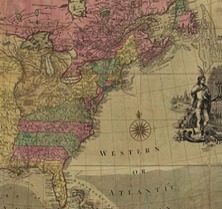INDEPENDENCE: 1783-1791

So: the victorious Americans signed a peace treaty with Britain, designed a Great Seal of the United States (above), inaugurated John Hanson as the first president of the United States (under the Articles of Confederation)—and then peered into the sobering future of Independence. Can we maintain our hard-won freedom? Can we reconcile with the Loyalists? Can we unify our thirteen states into a sovereign nation, worthy of global respect? What image should we promote among Europeans? What values and traits should we herald as American? What IS an American, now that we are independent? Daunting challenges.
Sections in INDEPENDENCE
Each section presents primary resources, introductory notes, classroom discussion questions, and supplemental links.
- Victory & Union
- - Thomas Paine, The American Crisis, #13, 1783
- - Gen. George Washington, Farewell Letter to the States, 1783, excerpts
- - Newsboys' new year's greetings after independence, five poems, 1784-1790
- - Chart: "Advantages" and "Disadvantages" of the American Revolution
- Promise & Peril
- - David Ramsay, The History of the American Revolution, 1789, excerpts
- - Mercy Otis Warren, History of the Rise, Progress, and Termination of the American Revolution, 1805, excerpts
- - Richard Price, Observations on the Importance of the American Revolution, 1784, selections
- - Chart: "Advantages" and "Disadvantages" of the American Revolution
- Progress & Identity
- - Founding documents of societies to promote progress and national identity, 1780-1791, selections
- - Noah Webster, essays on fostering American identity, 1783 & 1787, selections
- - Chart: "Advantages" and "Disadvantages" of the American Revolution
- Patriots & Loyalists
- - Alexander Hamilton & Isaac Ledyard, pamphlet war on the postwar treatment of Loyalists, 1784, selections
- - Chart: "Advantages" and "Disadvantages" of the American Revolution
- A Golden Age
- - The Golden Age: Or, Future Glory of North America, allegory by unknown author, 1785, excerpts
- - The Vision of Columbus, allegorical poem by Joel Barlow, 1787, excerpts
- - Chart: "Advantages" and "Disadvantages" of the American Revolution
- A New Man: The American
- - Michel-Guillaume Jean de Crèvecoeur (writing as J. Hector St. John), "What Is an American?" Letter III of Letters from an American Farmer, written late 1760s-early 1770s, publ. 1782, selections
- - Royall Tyler, The Contrast, comedy of manners, 1787
- - Chart: "Advantages" and "Disadvantages" of the American Revolution
- A Model for Europe
- - Abbé Claude Robin, New Travels through North America (1781), publ. 1782, selections
- - Jacques-Pierre Brissot de Warville, New Travels in the United States of America (1788), publ. 1791, selections
- - Chart: "Advantages" and "Disadvantages" of the American Revolution
- A Heads-Up for Europeans
- - Benjamin Franklin, Information to Those Who Would Remove to America, 1782, selections
- - Benjamin Rush, Information to Europeans Who Are Disposed to Migrate to the United States of America, 1790, selections
- - Chart: "Advantages" and "Disadvantages" of the American Revolution
Framing Questions
- How did Americans envision independence and nationhood in the first years after the Revolutionary War?
- How did they begin to construct a national identity separate from their colonial identity as British subjects?
- In what ways was the new nation like "a child just learning to walk"? What postwar challenges most reflected this "state of infancy"?
Images:
Banner Image: Final design for the Great Seal of the United States, 1782, by Secretary of State Charles Thomson (detail). Courtesy of the U.S. National Archives and Records Administration.
Block Image: Carington Bowles, Bowles's new map of North America and the West Indies, exhibiting the British Empire therein with the limits and boundaries of the United States as also the dominions possessed in that quarter, by the Spaniards, the French & other European states, the whole compiled from the best surveys and authentic memoirs which have appeared to the present year, 1783 (detail), London, 1783. Library of Congress, Geography & Map Division, Call No. G3300 1783 .B6 Vault. Courtesy of the Library of Congress.



